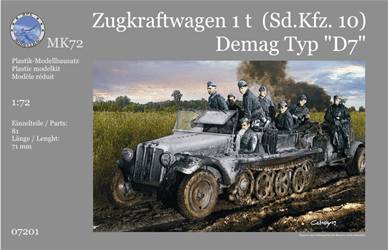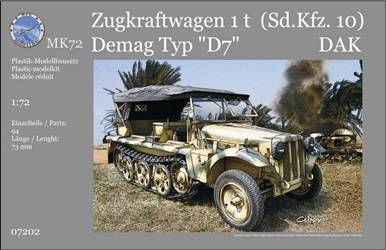Zugkraftwagen 1t (Sd.Kfz.10) Demag "D7" |
||||
Kit # 7201 & 7202 |
Preview by Rob Haelterman - heman_148(at)hotmail(dot)com |
|||
Zugkraftwagen 1t (Sd.Kfz.10) Demag "D7" |
||||
Kit # 7201 & 7202 |
Preview by Rob Haelterman - heman_148(at)hotmail(dot)com |
|||
  Pictures from Henk of Holland website, used with permission. |
| History The Demag D7 was built from 1938 till
1944; about 17500 were built and it served on all fronts. A (series
of) high quality kit(s) of this vehicle was thus long overdue. Important sub-versions were the Sd.Kfz.10/4
(which mounted a Flak 30) and the /5 (with Flak 38), so we can hope
these will soon appear in kit-form too.
Type of kit Injection plastic kit with manual and
decals. Clear acetate is provided for the windshield. Both kits are basically similar, except for a small number of parts and the marking options. All parts for both versions are provided on the single sprue.
Packaging Side-opening cardboard box. Parts themselves
are protected by a re-sealable plastic bag inside.
Quality Detail is crisp. I would judge it better
than the newer Attack kits, on par with Academy and just slightly
below Revell. The running gear follows a style that
is fairly well-established in the meantime (e.g. Dragon, Revell, Maco)
with the back rows pre-assembled for perfect alignment. What is novel
is the one piece styrene tracks which are to be used a bit like DS
tracks, but without being DS. While some modelers have shown weariness
regarding this approach, I have good hopes that it will actually work
out well, as I have tried this method previously on other kits (e.g.
the Maco sWS).
It actually gave far better results around the idler and drive sprocket,
since I have the impression I never can get the individual links perfectly
(optically) aligned. The tracks are two links too long, for reasons
I ignore. I first thought this pointed to a forthcoming Sd.Kfz.250,
but its tracks are actually shorter, not longer. The crew compartment is an insert that fits into a lower hull assembly. Interior detail seems very good on the sprues. A nice touch is the choice between headlights with a slit cover and hollowed out alternatives, which you can fill with transparencies of your own choosing. An abundance of jerrycans is provided,
which are mostly meant for the DAK version. They come in halves, so
some assembly/sanding will be required. It also means the middle handhold
is missing.
Manual The manual is very clear and of the "classical type". Scans of the manual can be found at http://henk.fox3000.com/mpk.htm
Version For as far as I can tell from my references,
the kit seems to have strengthened outer roadwheels which were introduced
at the end of 1940. In all, I would say that the kit would do for any 1941-1945 setting.
Camouflage & Markings Kit 7201 offers 5 marking options,
all of vehicles in uniform Panzer Grey (RAL7021):
Kit 7201 offers 3 marking options,
all of vehicles in a uniform sand color. The color chart next to the
color painting would lead me to believe this is either RAL1027 or
RAL6006, which I find odd, as I always thought vehicles were painted
RAL 8000 + RAL7008 from March 1941, and RAL 8020 + RAL7021 from March
1942 onwards on the North African front.
References [1] Die Halbkettenfahrzeuge des deutschen Heeres 1909-1945, W.J. Spielberger, Band 6 der Reihe Militärfahrzeuge. Motorbuchverlag 1993 [2] Leichter Zugkraftwagen 1t (Sd.Kfz.10) Ausf. A und B and Variants, T.L. Jentz & H.L. Doyle, Panzer Tracts 22-1, 2009
Preview samples kindly provided by Henk of Holland. |
| Back to MK72(MPK) Kit List | Back to Home Page |
Article Last Updated: 15 July 2010 |